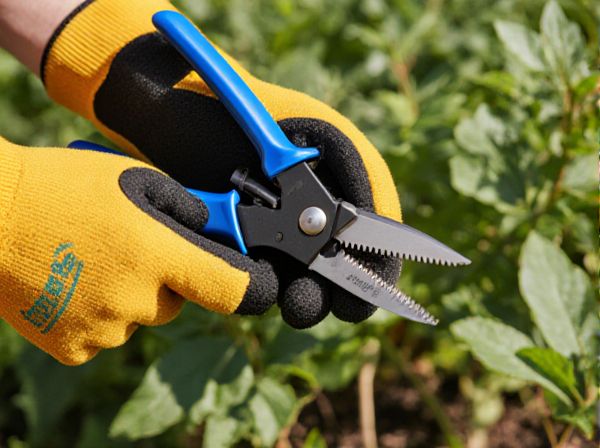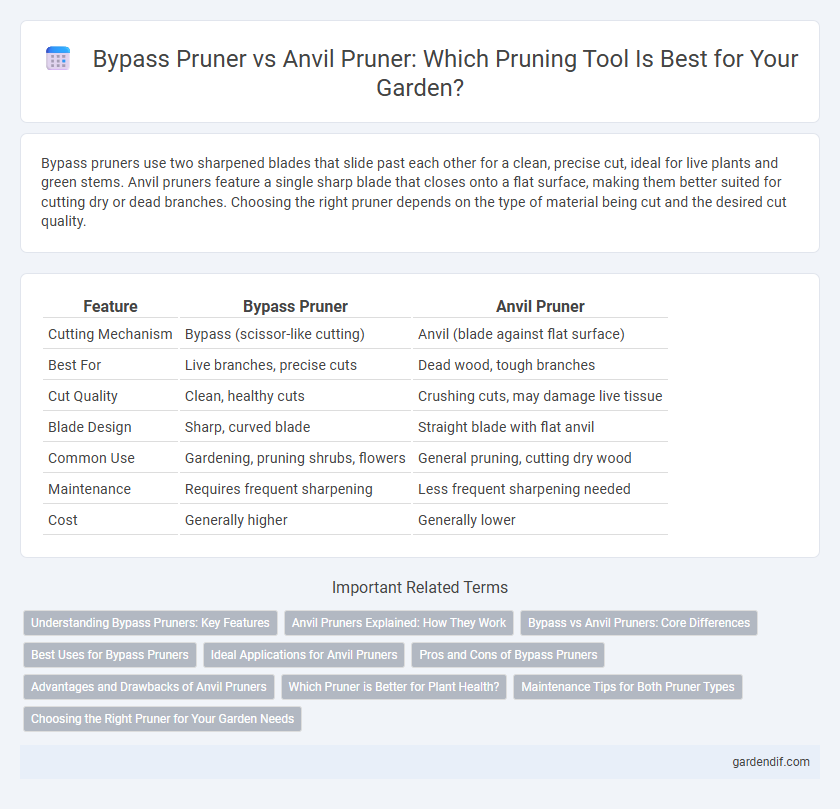
Bypass Pruner vs Anvil Pruner Illustration
Bypass pruners use two sharpened blades that slide past each other for a clean, precise cut, ideal for live plants and green stems. Anvil pruners feature a single sharp blade that closes onto a flat surface, making them better suited for cutting dry or dead branches. Choosing the right pruner depends on the type of material being cut and the desired cut quality.
Table of Comparison
| Feature | Bypass Pruner | Anvil Pruner |
|---|---|---|
| Cutting Mechanism | Bypass (scissor-like cutting) | Anvil (blade against flat surface) |
| Best For | Live branches, precise cuts | Dead wood, tough branches |
| Cut Quality | Clean, healthy cuts | Crushing cuts, may damage live tissue |
| Blade Design | Sharp, curved blade | Straight blade with flat anvil |
| Common Use | Gardening, pruning shrubs, flowers | General pruning, cutting dry wood |
| Maintenance | Requires frequent sharpening | Less frequent sharpening needed |
| Cost | Generally higher | Generally lower |
Understanding Bypass Pruners: Key Features
Bypass pruners feature two curved blades that slide past each other like scissors, allowing for precise and clean cuts essential for healthy plant growth. Their sharp, narrow blades minimize damage to stems and branches, making them ideal for delicate pruning tasks. Unlike anvil pruners that crush stems with a single blade against a flat surface, bypass pruners reduce plant stress and promote faster healing.
Anvil Pruners Explained: How They Work
Anvil pruners operate with a single straight blade that presses down onto a flat surface, or anvil, effectively cutting through branches with precision and power. Designed for tough, dry, or dead wood, anvil pruners provide a clean and strong cut by crushing the material against the anvil, minimizing effort and maximizing efficiency. This mechanism distinguishes them from bypass pruners, which use a scissor-like action suitable for live, green branches.
Bypass vs Anvil Pruners: Core Differences
Bypass pruners feature two sharp blades that pass by each other like scissors, providing clean cuts ideal for live branches and stems, minimizing plant damage. Anvil pruners use a single sharp blade that cuts against a flat, anvil-like surface, making them better suited for cutting dry or dead wood due to their crushing action. The core difference lies in the cutting mechanism: bypass pruners offer precise slicing for healthier plants, while anvil pruners deliver more force but can cause more damage to living tissues.
Best Uses for Bypass Pruners
Bypass pruners are best suited for cleanly cutting live plant stems and branches up to 3/4 inch thick, making them ideal for delicate pruning tasks such as trimming flowers, herbs, and softwood branches. Their sharp, scissor-like blades ensure precise cuts that promote faster plant healing and reduce damage to the plant tissue. Gardeners often prefer bypass pruners for shaping shrubs and roses where accuracy and plant health are priorities.
Ideal Applications for Anvil Pruners
Anvil pruners are ideal for cutting through dry, dead branches and tough woody stems up to 1.5 inches in diameter, offering precise, clean cuts with minimal effort. Their single straight blade presses against a flat anvil, making them perfect for pruning shrubs, deadheading perennials, and trimming hardier plants without crushing the stems. Professional gardeners and landscapers often prefer anvil pruners for heavy-duty tasks that require strong cutting power and durability.
Pros and Cons of Bypass Pruners
Bypass pruners feature two curved blades that pass each other like scissors, providing clean and precise cuts ideal for live plant stems and branches without crushing the tissue. Their ergonomic design reduces hand fatigue, making them suitable for frequent use, but their cutting capacity is generally limited to thinner branches compared to anvil pruners. While bypass pruners excel in accuracy and plant health preservation, they typically require more maintenance to keep blades sharp and may struggle with tougher or dead wood that anvil pruners handle more efficiently.
Advantages and Drawbacks of Anvil Pruners
Anvil pruners feature a single straight blade that crushes branches against a flat metal surface, offering powerful cuts suitable for hard or dead wood. Their advantage lies in requiring less hand strength, making them ideal for users with limited grip, but the crushing action can damage live plants and cause tearing. Compared to bypass pruners, anvil pruners are less precise and best reserved for rough pruning tasks rather than clean, healthy branch cuts.
Which Pruner is Better for Plant Health?
Bypass pruners feature a scissor-like action that cleanly cuts live plant stems, minimizing damage and promoting faster healing, making them ideal for maintaining plant health. Anvil pruners crush the stem against a flat surface, which can cause bruising and increase the risk of disease in living plants. Gardeners prioritizing plant health and precise cuts should choose bypass pruners for their superior performance in preserving tissue integrity and reducing infection potential.
Maintenance Tips for Both Pruner Types
Bypass pruners require regular sharpening of their blades and thorough cleaning after each use to prevent sap buildup and ensure smooth cutting action. Anvil pruners benefit from frequent lubrication of the pivot joint and periodic tightening of screws to maintain alignment and reduce wear. Storing both types in a dry place and applying a light coating of oil after maintenance helps protect against rust and extends tool lifespan.
Choosing the Right Pruner for Your Garden Needs
Bypass pruners offer precise, clean cuts ideal for live plant tissue, preventing damage and promoting healthy growth, making them perfect for delicate branches and flowering shrubs. Anvil pruners, featuring a single straight blade that cuts against a flat surface, excel at cutting dry, dead wood and tougher stems due to their powerful crushing action. Selecting the right pruner depends on the type of plants in your garden and the pruning tasks, with bypass models suited for live plants and anvil pruners optimized for hardier, woody material.
Bypass Pruner vs Anvil Pruner Infographic

 gardendif.com
gardendif.com